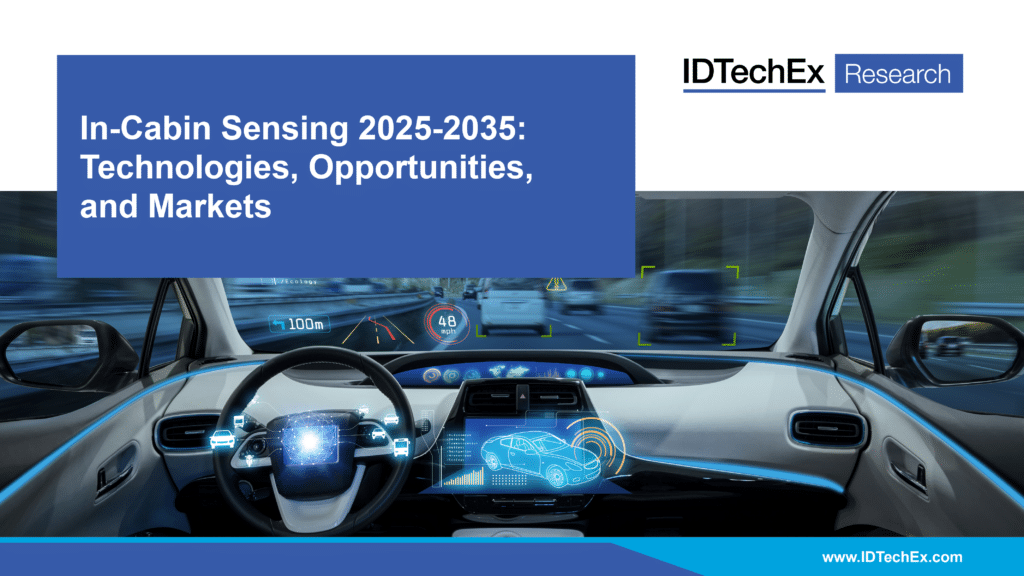For more information, visit https://www.idtechex.com/en/research-report/in-cabin-sensing-2025-2035-technologies-opportunities-and-markets/1077.
The Yearly Market Size for In-cabin Sensors will Exceed $6B by 2035
Regulations like the Advanced Driver Distraction Warning (ADDW) and General Safety Regulation (GSR) are driving the growing importance of in-cabin sensing, particularly driver and occupancy monitoring systems. IDTechEx’s report, “In-Cabin Sensing 2025-2035: Technologies, Opportunities, Markets”, examines these regulations and explores key technologies, including near-infrared (NIR) cameras, radar, time-of-flight (ToF) cameras, AI/software-defined vehicles, torque steering sensors, and capacitive steering sensors. This report provides an in-depth look at regional trends, technologies, and regulations, highlighting emerging market opportunities for in-cabin sensors in the automotive industry. It includes detailed regional forecasts by technology type, covering:
- A 10-year market size forecast for in-cabin sensors, segmented by NIR cameras, radar, ToF cameras, capacitive steering sensors, and torque steering sensors.
- A 10-year market size forecast for in-cabin NIR cameras, broken down by China, USA, Europe, Japan, and the rest of the world.
- A 10-year market size forecast for in-cabin radar, segmented by China, USA, Europe, Japan, and the rest of the world.
- A 10-year market size forecast for in-cabin ToF sensors, segmented by China, USA, Europe, Japan, and the rest of the world.
- A 10-year forecast for torque and capacitive steering sensors for hands-on detection, split by China, USA, Europe, Japan, and the rest of the world.
- A 10-year passenger vehicle forecast, broken down by China, USA, Europe, Japan, and other regions.
- A 10-year forecast for passenger vehicles by SAE levels 1 to 5.
DMS and OMS Technology Roadmap
In-cabin sensing is generally divided into driver monitoring systems (DMS) and occupant monitoring systems (OMS). DMS is expected to become mandatory due to regulatory pressures, while OMS is anticipated to be adopted primarily for mid- to high-end vehicles as a differentiator. DMS monitors driver conditions like drowsiness and distraction, while OMS focuses on tracking passengers, such as detecting unattended children or monitoring vital signs. As of early 2025, the leading DMS technology is the combination of NIR and RGB cameras, as NIR light does not distract the driver. With computer vision software, these systems can detect features like eyelid movement and gaze, helping to identify driver fatigue or distraction. NIR cameras consist of two essential components: an NIR illuminator (usually an LED) and an NIR imager. Alongside drowsiness detection, hands-on detection (HOD) plays a crucial role in ensuring safety. Traditional HOD systems use steering torque sensors, though they can be prone to false positives. As a result, capacitive touch sensors, which offer better performance, are increasingly being adopted. However, to reduce costs, many automotive OEMs are opting to combine NIR+RGB cameras with torque sensors, as both are already required in vehicles, minimizing the need for additional capacitive sensors, which typically cost around $2-5 each.
OMS, on the other hand, is generally non-mandatory, but many automotive manufacturers are integrating sensors such as radar. Radar modules are useful for monitoring occupant vital signs like heart and respiration rates. Additionally, the mmWave technology used in radar can penetrate physical barriers, making it effective for detecting rear-facing infants in child seats. However, radar modules tend to be expensive, limiting their use to mid- to high-end vehicle models.
The report also includes a 10-year outlook on the adoption of various in-cabin sensing technologies, along with the use of these sensors across key regions including China, USA, Europe, Japan, and the rest of the world. IDTechEx believes that driven by the regulations as well as the pursuit of differentiations of modern vehicles, the in-cabin sensors will continue to grow.
 Market size forecast of in-cabin sensors, IR cameras, radar modules, ToF cameras, capacitive, and torque steering sensors. For full data, refer to In-Cabin Sensing 2025-2035.
Market size forecast of in-cabin sensors, IR cameras, radar modules, ToF cameras, capacitive, and torque steering sensors. For full data, refer to In-Cabin Sensing 2025-2035.
AI, software-defined vehicles and in-cabin sensing
A major trend is integrating in-cabin sensing with software-defined vehicles. Due to ADDW regulations, automotive OEMs will need to use components like NIR+RGB cameras, which can also support additional features. One key strategy is to combine these sensors with AI and software-defined vehicle technologies, enabling capabilities like driver profile identification and personalized configurations. IDTechEx’s report highlights the role of AI in enhancing vehicle functionalities, showcasing real-world use cases.


